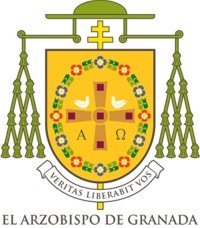Biography
Description of the episcopal coat of arms of Archbishop Javier Martínez Fernández

An episcopal appointment is linked to the choice of a coat of arms which expresses the aim which drives the episcopal mission, a particular conception of the Church and a viewpoint of mankind.
Frequently, episcopal coats of arms are composed of heraldic symbols which represent personal ideals, family traditions, or references to the name itself or to particular passions. Nevertheless, the coat of arms chosen by Javier Martínez Fernández, more than a heraldic concept or complicated symbolism, presents a very simple and clear image.
The frame is common to the majority of coats of arms, and so it follows the traditional shape of the chalice, evoking the centrality of the Eucharist. It is crowned with the green “capelo” (the ecclesiastical hat known since the 13th century) which has the 20 tassels which show the dignity of the archbishop. Under the hat is the habitual golden episcopal cross of two crosspieces.
The content of the coat of arms follows a personal choice. In the center, an exact reproduction of a victory cross which is supported by an angel in a Coptic tapestry of the 6th - 7th century conserved in the Louvre Museum. This reveals the proximity of the prelate to the Christian Orient.

The cross shows the five sacred wounds which attest to the Resurrection of Christ. It represents the climax of the Incarnation, the expression of the intention of Christ to join man in what is more a strictly human condition: suffering. And above all, an expression of the greatest love.
However, the cross is not alone, and is surrounded by a wreath composed alternately of flowers (a sign of the fertility of Paradise) and laurel leaves (an imperial representation of the victory retaken by the first christians).
The presence of the cross is imposing. Nevertheless, it does not constitute the first nor the last word of the christian experience. The first word is Beauty, because where it exists there arises a Mystery which is greater than both pain and death. From this emanates a Light capable of supporting man, although he may be surrounded by darkness. That Beauty constitutes the Glory (the first word that appears in the Gospel when Christ is born), which signifies the resplendence of the Beauty of God. To show that Beauty is the main work of the Church.
However, the cross is not the last word either, but the morning of Easter, in which the love of God defeats death and rescues us from our miseries. That certainty is what the first christians expressed with flowers and laurel.
Over the cross in the centre of the coat of arms rest two opposing doves. This motif shows the classical legacy of Roman art, which will remain in Chrisian iconography as a symbol of peace, innocence and happiness. Accompanying them are “alpha and omega”, the first and last letters of the Greek alphabet which the Apocalypse stresses in three different verses (Ap 1,8; 21,6 y 22,13) as an expression of the Lord, the beginning and the end of creation. It refers to a much repeated symbol during the first centuries of christian life.
Curiously, the word “emet”, which in hebrew means “truth” is formed by three letters: the first, the middle and last letters of the Hebrew alphabet. In this way it connects to the subject chosen for the coat of arms. The motto, which significantly is written in Latin, is framed by a phylactery and quotes the verse from the gospel John 8, 32: “The truth will make you free”.
As opposed to relativism, the truth always appears as an essential matter of faith. However, the specific context of the gospel from which this quote is taken goes much further: it reveals that Truth is Christ, the only possibility that man be truly free. It is not merely a moral truth, but personal, and for this reason the key lies not in adhering to it, but in allowing oneself to be embraced by it, by Christ himself.
This is the plan foreseen by God to make us happy, to give us freedom. A freedom which consists in the capacity to recognise the fundamental essence of human life and strengthen it. Only from this truth and freedom are possible the “parresia”, “freedom of speech” (the intrepid frankness of faith), the gift of oneself, and the gratefulness and the pleasure for life which characterise the christian experience.
Truth and liberty entwined rule the coat of arms, under the light of the victory cross marking a path and a destination. The cross, the “alpha and omega” and the motto represent a three-way affirmation which constantly refers to Christ, the only protagonist of this episcopal coat of arms.
María José Muñoz,
Director of the Diocesan Museum of Córdoba




